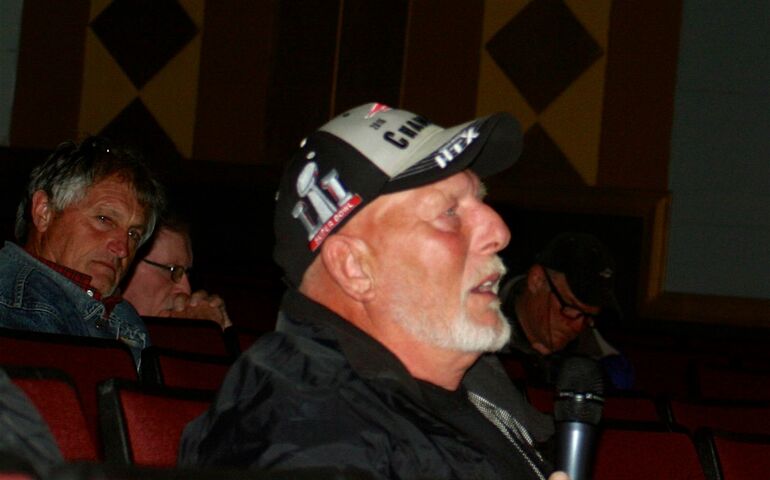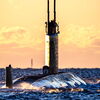
Maine proposes targeted exemptions to help lobster industry weather whale crisis
 Photo / Laurie Schreiber
At a Maine Department of Marine Resources meeting last night in Ellsworth, fishermen listened as Rocky Alley, president of the Maine Lobstering Union and a Jonesport lobsterman, commented on what he termed “bad science” underlying the perception that Maine’s lobster industry is a threat to the North Atlantic right whale.
Photo / Laurie Schreiber
At a Maine Department of Marine Resources meeting last night in Ellsworth, fishermen listened as Rocky Alley, president of the Maine Lobstering Union and a Jonesport lobsterman, commented on what he termed “bad science” underlying the perception that Maine’s lobster industry is a threat to the North Atlantic right whale.
The state is proposing a modified plan to protect the endangered North Atlantic right whale while creating less hardship for the lobster fishing industry than a proposed federal plan.
Maine Department of Marine Resources Commissioner Patrick Keliher presented the proposal in Ellsworth Monday night, at the first of three meetings being held this week by the agency.
Maine’s lobster industry, many said, was being unfairly targeted.
“We’ve seen bad science against lobster fishermen in the state of Maine,” said Rocky Alley, president of the Maine Lobstering Union and a Jonesport lobsterman. “When will they come up with new science that makes sense? How many whales have we killed?”
“In the last decade, directly, with Maine gear on them? None,” responded Keliher.
But, he added, “as long as we’re 64% of all endlines on the East Coast, and 90% within all the lobster management areas, we’ll continue to have a bull’s-eye on our back.”
In June, the federally convened Atlantic Large Whale Take Reduction Team came up with a plan to reduce the risk of entanglement by North Atlantic right whales in lobster fishing gear by 60%.
The risk reduction strategy included removing half the number of lobster trap endlines in the water and using weak rope in the top of remaining endlines, which are the vertical lines that connect lobster traps on the ocean bottom with a buoy at the sea surface.
But the state's modified plan being presented this week hinges on an existing nearshore exemption area that spans the Maine coast and was established in 2014 to exempt lobster fishermen from new vertical-line rules implemented at the time, also to protect right whales. The parameters of the area were based on data overlays that showed right whales weren’t appearing where nearshore fishing was taking place.
The DMR proposal
At last night’s meeting, Keliher said the agency’s plan incorporates the same exemption area this time around, too.
The federal plan calls for halving the number of vertical lines used by the industry. That’s 5.5 million vertical lines overall.
But most of Maine’s lobster fishing takes place in the nearshore exemption area. The state plan would take over 4 million vertical lines off the table.
“Now we’re talking about a reduction from only about 1.4 million endlines,” he said.
The reduction of endlines outside the exempted area will mean that fishermen will have to connect more traps to their endlines, a process called “trawling up.”
The state plan proposes:
• In the nearshore exemption area — no changes
• From the exemption line to 3 miles from shore — a minimum of three traps per trawl
• 3-6 miles from shore — a minimum of eight traps per trawl with two endlines, or four traps per trawl with one endline
• 6-12 miles from shore — a minimum of 16 traps per trawl
• Beyond 12 miles offshore – a minimum of 24 traps per trawl.

The plan will be flexible enough to allow the agency to have conversations in individual lobster management zones about trap maximums.
Maine’s lobster industry uses 64% of all vertical lines on the East Coast and 90% within all lobster management areas, he said.
Gear-marking
Other measures in the state plan call for a system of “weak” links in the upper parts of the vertical lines. The weak links would allow the rope to be broken more easily by a whale that’s entangled in it. Studies have shown that right whales can break free of line at or under 1,700 pounds of pressure.
All of Maine’s lobster fishing vertical lines, inshore and offshore, would also be required to have a system of purple marks. The marking system is considered key to demonstrating whether or not whales are being entangled by rope coming from Maine gear. Location-specific marks are expected to provide more targeted data for researchers trying to determine the origin of gear involved in an entanglement. It will also allow researchers to differentiate gear found on entangled whales from Maine gear.
The plan also proposes a cell-service-based reporting system for all lobster fishermen. Better data is expected to help regulators develop targeted, effective regulations in the future. The fishermen’s monthly reports will include information on fishing location and effort. Implementation of harvester reporting will depend on funding from other sources. Keliher said it’s expected the data will also prove useful through the evolution of other offshore activities, such as siting issues related to the offshore wind industry.
The agency will submit the final proposal to the National Oceanic and Atmospheric Administration sometime this month, said Keliher. A period of public comment will follow.
“It’s incredibly important that fishermen participate,” he said.
The final rule is expected to be issued in the summer of 2020, with an implementation date likely in 2021, he added.
Fishermen generally expressed support for gear-marking, as a way to demonstrate their gear is not implicated in the entanglement of right whales.
“I support gear marking,” said Stonington fisherman Julie Eaton. “That’s urgently needed. Unfortunately, we’re guilty until we’re proven innocent by NOAA on this issue. So let’s clear our name and move on.”










0 Comments